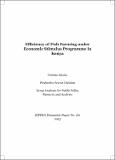Discussion Paper No. 181 of 2015 on Efficiency of Fish Farming under Economic Stimulus Programme in Kenya
View/
Publication Date
2015Author
Type
Discussion Paperviews
downloads
Metadata
Show full item recordBy
Nduku, Tabitha
Abstract/
Fish is very important for food and nutrition security throughout the world. However, fish stocks from the natural sources in Kenya have been declining, making fish farming the only viable option to supplement fish supply. This paper examines the efficiency of the Government intervention in fish farming through the Economic Stimulus Programme. It assesses the efficiency with which the constituencies (grouped into counties) used the allocated resources for fish production. Results show a mean average efficiency of 65 per cent in 38 counties. Counties near large water bodies were relatively less efficient, contrary to the major water source criteria used for the fish farming intervention. Further, only 89 per cent of the fish ponds were observed, an indication that there could have been ponds that were constructed and abandoned or were never constructed at all. Only 49 per cent of the targeted fish production level was achieved. The optimal fish production expected from the 48,000 fish ponds that were to be constructed under the programme was 31,680 tonnes annually. However, in 2014, the total quantity produced from fish farming was 24,096 tonnes. Based on the findings, fingerling production hatcheries need to be implemented in the counties without any public or private hatcheries. Kenya can further borrow from Egypt and Nigeria, the leading fish farming producers in Africa, an approach which is both an intervention by the Government and a market-led approach to increase fish production and provide an incentive for fish farmers to produce for the market.
Publisher
The Kenya Institute for Public Policy Research and Analysis (KIPPRA)Series
DP/181/2015Collections
- Discussion Papers [342]

